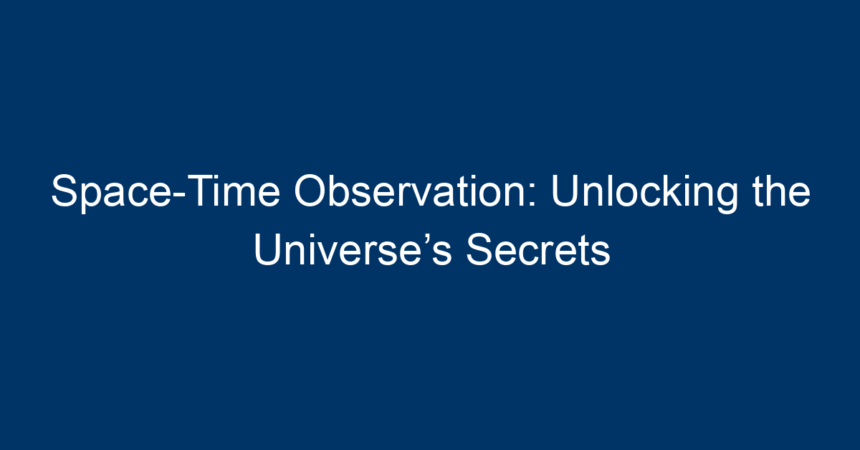In the vast expanse of the cosmos, countless mysteries await discovery. From black holes to the fabric of reality itself, the universe holds secrets that challenge our understanding of existence. One of the most profound ways we are beginning to unlock these mysteries is through space-time observation. This article aims to delve into the importance of space-time observation, exploring its role in astrophysics, cosmology, and even in our everyday lives.
What Is Space-Time?
Before diving into the nuances of space-time observation, it’s vital to understand what “space-time” actually refers to. Space-time is a four-dimensional continuum that merges the three dimensions of space with the dimension of time. This concept, introduced by Albert Einstein in his theory of relativity, radically changed how scientists understand the universe.
The Basics of Einstein’s Theory of Relativity
Einstein proposed that gravity isn’t merely a force but a curvature of space-time caused by massive objects. For instance, the Earth orbits the Sun not because it is pulled by an invisible force, but because the Sun warps the space-time around it. This groundbreaking perspective has profound implications that have only begun to be explored through space-time observation.
The Role of Space-Time Observation in Astrophysics
To grasp the universe’s dynamics, astrophysicists employ space-time observation techniques to measure cosmic phenomena. These observations help us understand everything from the life cycles of stars to the behavior of galaxies.
Understanding Black Holes
Black holes are one of the most enigmatic objects in the universe. Space-time observation has provided critical insights into these regions of intense gravitational pull. Observations from telescopes and spacecraft allow scientists to detect the gravitational waves emitted during black hole mergers. These waves offer a direct glimpse into the nature of gravity and space-time itself.
Mapping the Cosmic Microwave Background
The cosmic microwave background (CMB) is another area where space-time observation plays a crucial role. By studying the CMB, scientists can glean information about the early universe, including its age, composition, and the rate of its expansion. High-resolution observations of the CMB have revealed patterns that deepened our understanding of cosmic evolution.
Space-Time Observation and Cosmology
Cosmology, the study of the universe as a whole, employs space-time observations to decode the mysteries of cosmic events.
The Expansion of the Universe
One of the most significant discoveries in cosmology was that the universe is expanding. Measurements of distant galaxies through space-time observation techniques have led to the conclusion that galaxies are moving away from us, indicating that the universe has been expanding since the Big Bang.
Hubble’s Law
Hubble’s Law states that the farther a galaxy is, the faster it is receding from us. Space-time observation has enabled astronomers to quantify this relationship, leading to the formulation of critical theories about dark energy and the universe’s fate.
Dark Matter and Dark Energy
Dark matter and dark energy comprise a substantial portion of our universe, but they remain largely undefined. Space-time observations allow scientists to infer their existence and study their effects on visible matter and the universe’s expansion.
Technologies Driving Space-Time Observation
Several cutting-edge technologies have revolutionized how we observe space-time, enabling unprecedented measurements and analyses.
Ground-Based Telescopes
Ground-based telescopes have improved significantly, equipped with advanced adaptive optics that compensate for atmospheric distortions. Instruments like the Very Large Telescope (VLT) in Chile provide high-resolution images of celestial objects, revealing intricate details of the universe.
Space Telescopes
Space telescopes, such as the Hubble Space Telescope and the newly launched James Webb Space Telescope, play an indispensable role in space-time observation. By operating outside Earth’s atmosphere, these telescopes capture clearer images and spectra, providing insights into distant galaxies, star formation, and more.
Gravitational Wave Detectors
The advent of gravitational wave detectors like LIGO (Laser Interferometer Gravitational-Wave Observatory) has opened a new frontier in space-time observation. These detectors can measure the minute distortions in space-time caused by cosmic events, such as merging black holes or neutron stars. This innovative technology has not only validated Einstein’s theories but also provided new avenues for astronomical research.
The Impact of Space-Time Observation on Our Daily Lives
While the notion of space-time may seem abstract, its implications extend into our everyday lives. Technologies derived from space-time observations have transformed various fields, including GPS, telecommunications, and even healthcare.
GPS Technology
The Global Positioning System (GPS) relies heavily on the principles of space-time observation. GPS satellites orbiting Earth experience time differently than observers on the surface due to gravitational time dilation (a consequence of general relativity). Accurate GPS calculations depend on this understanding to provide precise location data.
Telecommunications
The timing and synchronization technologies used in telecommunications also stem from concepts of space-time. High-speed internet and cellular networks utilize principles of relativity to ensure efficient data transmission.
Future Directions in Space-Time Observation
As technology progresses, the future of space-time observation appears bright. Advances in quantum computing, artificial intelligence, and more sophisticated telescopes will likely enhance our ability to study the cosmos.
Building Next-Generation Telescopes
Plans for next-generation telescopes, such as the European Extremely Large Telescope (E-ELT), promise to push the boundaries of what we can observe. These telescopes aim to collect more light and provide deeper insights into the formation of galaxies, stars, and the early universe.
Interdisciplinary Research
The collaboration between astrophysicists, cosmologists, and engineers will drive innovations in space-time observation. Interdisciplinary efforts can lead to new technologies and methodologies for studying cosmic phenomena.
Conclusion: Embracing the mysteries of Space-Time Observation
As we continue to explore the universe, space-time observation serves as a pivotal tool for unraveling its mysteries. From understanding black holes to mapping the cosmic microwave background, these observations have reshaped our comprehension of existence.
While the technological advancements make the possibilities seem endless, they also remind us of how much remains to be discovered. By engaging in the ongoing dialogue surrounding space-time observations, we not only expand our scientific frontiers but also enhance our understanding of our place in the universe.
Actionable Insights
- Stay Informed: Keep up with the latest discoveries in astrophysics and cosmology by following relevant journals and news outlets.
- Engage With Local Astronomy Clubs: Join local astronomy clubs or organizations to participate in discussions and observe the night sky.
- Consider Higher Education: If you’re passionate about the universe, consider studying physics or astronomy. Every new mind contributes to the quest for knowledge.
- Support Space Research Initiatives: Take part in or support initiatives aimed at furthering space exploration and research.
By embracing the concepts of space-time observation, you contribute to a broader understanding of the universe’s secrets, inspiring future generations to continue exploring the infinite cosmos.




